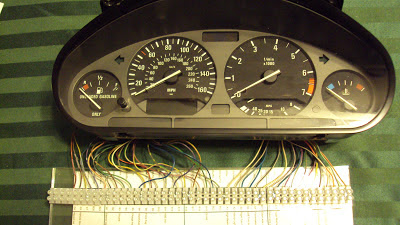Several EV sources offer rpm sensors that can be mounted on the
Warp 11. Some of the sensors provide a
2, 3, or 4 pulse output per motor revolution.
By contrast, the BMW rpm sensor provides 58 pulses per revolution. It may be possible to mount the original vibration
damper directly on the Warp 11 motor shaft.
This would provide the original 58 pulses per revolution which might then
interface directly to the BMW instrument cluster and/or the ecu without the use of
an adapter. Additionally, the damper incorporates two pulley wheels. One pulley can be removed, but the second is welded to the damper itself and it would be perfect for the future incorporation of belt driven accessories.
Picture DSC05255 showing original 58 tooth vibration damper. The crankcase position/rpm sensor is at 11:00. Removal of the plastic end caps on each pulley exposed the attachment bolts. Picture was taken after the removal of the six hub bolts and the auxiliary second pulley.
Removing the vibration damper (also called by some the
harmonic damper) did not disappoint in the challenge. The primary difficulty was to immobilize the M50 camshaft to prevent engine rotation while the 22 mm
hex bolt was loosened. Since the engine
was on its side in the shop, the oil pan was removed to expose the cam
shaft. A piece of wood was inserted
adjacent to the cam shaft to prevent its rotation but still, the bolt held fast.
Picture DSC05263 showing the insertion of a wooden block to prevent rotation of the camshaft during the removal of the 22 mm retaining bolt.
Subsequent use of an oxy-acetylene torch to
heat the hex bolt and adjacent donut shaped washer to nearly red heat, resulted
in the easy removal of the bolt. It was
necessary to remove some adjacent pulleys (bolts hiding behind the plastic end
caps !!) before the damper would slide off the 32.0 mm OD cam shaft.
Picture DSC05262 showing the removal of the 22 mm retaining bolt with its adjacent "donut shaped" spacer/washer.
The primary pulley appears to be welded to
the damper and six M8 x 18 bolts attach the outer pulley (D=122 mm) to the
damper. Only five bolts came out
without protest, and the sixth sheared in half, so additional effort will be
required to remove the remaining bolt threads.
To see an excellent exploded view diagram of the parts involved, go to
realoem.com and in the search field "Part NR Application Search" enter part number 11231730311, followed by selecting "Details for E36", then, select the "Belt Drive-Vibration Damper" tab in the "E36 325i Sedan, M50, Manual" category. From the diagram, replacement of hub part number 06 with a new hub whose ID is consistent with the Warp 11 motor shaft diameter, should allow the damper to directly mount to the Warp 11 motor.
The 3.93 kg vibration damper is a 60 tooth disk which has two teeth removed. When rotating, the 58 remaining teeth pass within 1 mm of the crankshaft position sensor/rpm sensor (CPS). The engine mounted CPS was damaged during attempted removal, so an EBay replacement was purchased from carpartswholesale for $24.25 .
Picture DSC05267 showing the mesial face (closest to the engine) of the vibration damper (note the sheared bolt at 4:00 !!)
Picture DSC05268 showing the distal face (closest to the radiator) with integral pulley.
Picture DSC05272 showing the side view of the 3.93 kg vibration damper. The outer pulley has already been removed. Using a lathe, it may be possible to thin the metal disk adjacent to the teeth to reduce the weight of the damper if desired. The integral attached pulley may allow the future incorporation of belt driven accessories.









